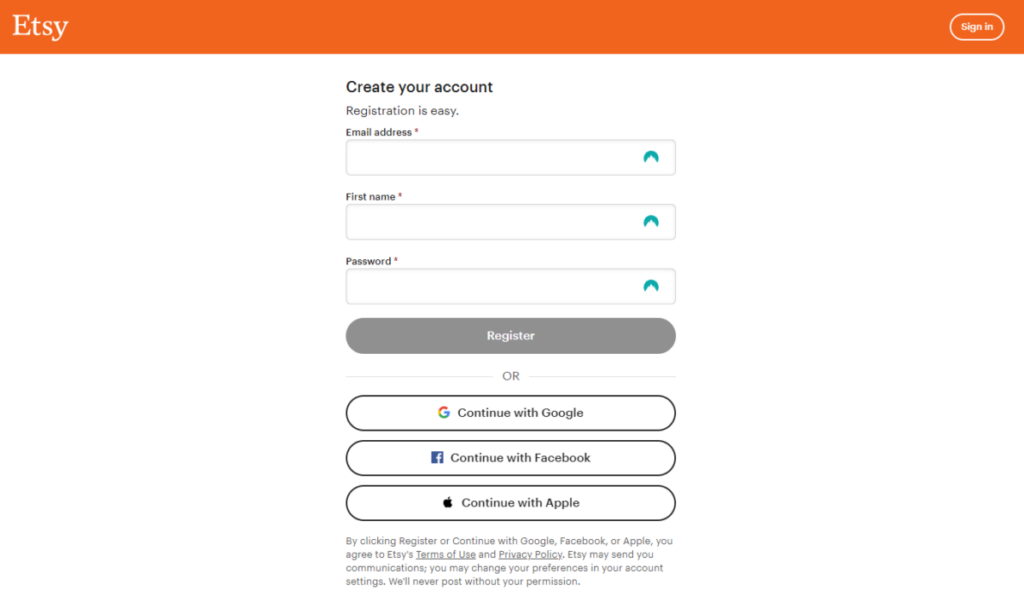How Does Etsy Work – Etsy Essentials You Must Know
One can find plenty of e-commerce sites for buying and selling generic mass-produced goods. However, only a handful of quality marketplaces provide customers access to unique handmade products.
Etsy has created a name for itself in the handmade niche. The moment someone spells out “handmade” and “vintage”, you instantly think of Etsy! Such is the pull of this trendy marketplace.
For a company with humble beginnings, Etsy has indeed made it big. According to the Statista Research Department, Etsy generated revenue worth 2.6 billion dollars in 2022, a steady increase from 2.3. Billion dollars generated in 2021.
It was founded from an apartment in 2005. Etsy was created by Chris Maguire, Rob Kalin, and Haim Schoppik as the ideal marketplace for handmade art and craft products.
What started as a small cohort of creative entrepreneurs has now grown to become a leading e-commerce platform. But Etsy’s USP is still the handmade tag.
Hello there! If you want to start an Etsy business, check out their awesome handmade collection, or are simply curious to know more about them, we are here to help. In this post, we will tell you all about how Etsy works. We will give you a comprehensive overview of all Etsy features and how Etsy works for both buyers and sellers.
Etsy is a great platform for starting a creative business. But it has a few strict rules you must know about before taking the plunge. As a seller, you want to be sure that Etsy is the right platform for your products. Also, you want to know all about Etsy’s modus operandi so that you can use it in the best possible way to make money.
You would get a lot of information from the Etsy site as well. But it would be scattered in bits and pieces. You would get some from their main site and some from their blog posts. But putting all that stuff together and joining the dots can be difficult. That’s why we have simplified the task for you! In this post, we‘ve put together a comprehensive Etsy guide that covers a lot of ground.
In a nutshell, these are a few main points we’ll be covering in the following sections:
- How to Use Etsy for Buyers and Sellers
- How does Etsy differ from other e-commerce platforms
- How does the Etsy algorithm work
- What are the different kinds of fees charged by Etsy
- What kind of products can you sell on Etsy
- Tips & Tricks to Sell Well on Etsy
Is Etsy Only for Handmade Products?
It’s the first thing sellers want to know before investing in setting up an Etsy business.
Is Etsy meant only for handmade products?
To put out the facts clearly, Etsy is a platform for selling handmade products, vintage items, and craft supplies. Technically, vintage items and craft supplies don’t have to follow the handmade criteria strictly. The main pre-condition for selling vintage goods is they are at least 20 years old. The handmade criteria don’t apply to craft supplies because these are like raw materials for creating handmade goods you sell in bulk.
Besides the vintage and craft supplies items, anything else sold on Etsy must be handmade. If it hasn’t been designed and handmade by you but by a bunch of artisans hired by you, you must specify this in your Etsy shop’s About Us page.
Although you might still see some Etsy shops with mass-produced goods, it’s best to follow their guidelines and sell only handmade products. Since the platform has gotten so huge, it’s probably hard to keep track of all the stuff sold there. But their company policies are well stringent. Listings for mass-produced items are removed from time to time.
Does Selling on Etsy Cost Money?
It is free to set up an Etsy shop and create product listings.
But Etsy charges sellers different kinds of fees at different stages of selling.
So yes, selling on Etsy does cost money. But it’s a fair system. The commission you pay Etsy depends on the volume of sales you make, so it’s not like you are treated unfairly.
Etsy charges sellers through a multi-tier fee structure including listing fees and selling fees, along with a percentage cut from overall sales. We will explain this in detail in the later part of the post when we will tell you all about Etsy’s revenue model.
Etsy Business Model
Another question that preoccupies many sellers is what is Etsy’s business model.
Its business model is pretty much on the lines of that practiced by major e-commerce giants like Amazon, Shopify, etc. It’s an online marketplace for buying and selling unique handmade crafty goods. Etsy provides opportunities for small entrepreneurs to set up their shops and gives them access to a ready customer base.
There are some differences between how Etsy operates and how a mainstream e-commerce platform like Amazon would.
Etsy’s e-commerce business model has a vertical approach, that is, it focuses on selling art and craft items in specific niches. You won’t find any typical products on Etsy They specialize in certain categories of handmade goods like Jewelry, Home Decor Products, Craft Supplies, Custom Art, Custom Clothing, Vintage Products, Personalized Clothing, Handmade Skincare and Wellness niche, etc. Within these categories, they would offer different kinds of unique items and gifts.
On the contrary, an e-commerce company like Amazon follows a horizontal business model where they sell almost anything and everything.
There is a sense of exclusivity attached to whatever you buy on Etsy. This platform doesn’t so much run on the usual marketplace logic of cheap vs. expensive. Customers who browse Etsy already know they are here for something unique and exclusive. For the typical Etsy customer then, pricing would be secondary, and their primary concern would be the uniqueness and quality of the product.
What All Can You Sell on Etsy?
You can only sell vintage items, handmade products, and craft supplies & tools on Etsy.
Anything mass-produced isn’t ideal for this platform. That’s why Etsy is great for creative entrepreneurs looking to start their businesses. If you are an artist passionate about creating something but don’t know how to start, Etsy is just the avenue for you.
These are some popular categories of items you can sell in your shop on Etsy:
- Customized and handmade Jewelry
- Vintage Items
- Clothing
- Stickers
- Home Decor Items
- Digital Downloads
- Wedding Products & Gifts
- Craft Supplies & Tools
- Party & Festive Gifts
- Custom Wall Art
- Organic Skincare & Wellness Products
- Toys & Entertainment
- Shoes
What Can You Not Sell on Etsy?
It’s equally important to know about the stuff you cannot sell on Etsy.
Etsy prohibits you from selling certain kinds of items, and they are very strict with their prohibitory policies.
Etsy has a rather detailed Prohibited Items Policy that you can access from their main website via the About Us section. In a nutshell, these are the major categories of items they prohibit from being sold on their platform:
- Alcohol & Drugs
- Medical Drugs & Devices
- Items Making Medical Claims
- Human Remains & Animal Products
- Items that Support, Glorify, or Promote Hatred
- Dangerous Items Including Weapons & Hazardous Material
- Illegal Items & Highly Regulated Goods
- Items that are Internationally Regulated
- Items Promoting or Glorifying Violence
- Nudity & Mature Content
Certain categories of prohibited items on Etsy can be confusing and subjective. For example, how would one define items that glorify hatred? Or how does one define the category of items making medical claims?
Shop owners should go through the Etsy Prohibitory Policy in detail before making the final decision regarding a product.
They also give examples of the kinds of products that can’t be sold and those that can be sold under each category.
Etsy- How Does it Work for Buyers and Sellers?
The Etsy marketplace has two main stakeholders – buyers and sellers.
You can use Etsy to buy unique and exclusive handmade or vintage products from businesses that have set up an Etsy shop to sell them. As a seller, you can use Etsy to create a side income stream or launch a full-fledged creative brand by opening your own shop on the platform.
It is a model of shared success – more sellers in the Etsy marketplace would translate into more buyers, thus increasing the platform’s revenue.
Let’s check out in detail how to use Etsy for buyers and sellers.
Etsy for Buyers
How do you use Etsy for shopping?
It’s simple. You begin your Etsy shopping experience with browsing, pretty much like you would do on any other online platform.
You use keywords related to the items you are looking for and browse products that the Etsy search engine shows up. For example, if you are looking for some handmade jewelry, simply key in the terms “handmade jewelry” or just “jewelry” and you’ll come across many product options. If you are looking for something more specific like let’s say bead bracelet or bead necklace, then you could use these exact keywords, and Etsy will show you the relevant results.
Etsy search engine is quite reliable in showing precise search results making the whole experience convenient for buyers.
Many buyers use Etsy for buying gifts. If you are looking for gifts in general and are not sure about what to buy, use relevant keywords like “ gifts for men, “ gifts for women”, “gifts for mom”, “Christmas gifts” etc., and the algorithm will show up a lot of interesting results.
When you type in the keywords, the Etsy search engine shows you results both by listings and sellers. You could also browse for products by the shop names and then sort the results as per shop ratings and other parameters.
You can then click on the products you are interested in and read more about the product details including sizing, materials, pricing, etc. It differs from seller to seller. Some sellers will give you detailed information about the manufacturing process and the sustainability of the products, while others will give you brief info. As a buyer, it’s up to you to assess the information and make up your mind.
You could also check out the “About” section of the shop. That will give you a fair idea of their background story and the kind of items they sell. It could give you leads for checking out other similar products you might be interested in.
The most obvious criteria for making the final purchasing decision are product photos.
The listing should include many product photos showcasing the product from multiple angles. You must look at the pics carefully to be sure about the look of the product before you decide to buy it.
Another thing to keep an eye out for is customer reviews. You can view the overall ratings of the shop and check out the reviews left by other buyers.
You can also add the shop items to your “ favorites” or to lists. You can also send a “Message” to the sellers if you want to ask something about their items or selling policies.
Also, you have the option to rate sellers and leave reviews of items you’ve purchased.
The checking out process works pretty much like any other e-commerce site. Once you are ready, you’ll be asked to review your cart and confirm the purchase.
You can use many payment methods for checking out. These include Credit Cards, Debit/bank Cards, PayPal, Google Pay, Apple Pay, and Etsy Gift Cards and Credits.
The mode of payment you can use while checking out depends on the seller. Some sellers accept all these modes, while others accept only some.
The “Payment” section of the shop shows you all the options you can use for making the purchase.
Etsy for Sellers- How to Set a Shop
You can sell so many creative things on Etsy.
Whether you are a first-time entrepreneur or a small business wanting to consolidate your brand, Etsy has something in store for everyone!
Let’s guide you through the whole process of getting started on Etsy as a seller and setting up your shop.
- Create a free Etsy account.
- Next, set up your Etsy shop. Choose a name for your shop, specify the language preferences, the country you are selling from, and the currency you’ll use for transactions.
- Now start creating your shop’s product listings. Use relevant tags, titles, and product photos.
- Fill in the “ About” section of your Etsy store.
- The next step is to set the price structure of your products under the Inventory and Pricing Section. Enter the amount the customer is expected to pay for the item and the number of items available. You can also include variations such as different colors or sizes.
- The final step is to upload the shipping information. Remember that this info is extremely important for the customer. Be as specific as you can – how long do you typically take to pick up the order, get done with the packing, and finally ship the product.
- Choose how to get paid & set up billing. You enter your bank account details to receive customer payments. Once you’ve entered the relevant info regarding your bank account, you’ll be asked to choose a payment method. Most sellers these days go for Etsy payments since it integrates multiple payment options – Credit Cards, Debit Cards, PayPal, Google Pay, etc.
- You can now start customizing your Etsy storefront by creating a user profile, updating your shop description, and uploading your shop policies.
Etsy is a great place for building a solid customer base and strengthening your brand. But you must remember that SEO optimization of your product listings is the key to achieving success on this platform.
Whether you make and sell customized t-shirts or DIY pottery kits, remember that your Etsy store page is your best marketing pitch! You have to be creative, write compelling product descriptions, and use the right keywords.
You must put yourself in the customer’s shoes and anticipate the kind of terms they will be using when searching for a product. Not all people will be sure about what they want to buy. Many will just have a vague idea that they want to buy something unique and artsy as a gift. It’s your job to lead them on by sprinkling a generous dose of strategic keywords like “ Christmas Gifts”, “ Mother’s Day Gifts”, “ t-shirts for women”, etc.
You should also use the “ About “ section of your Etsy store page to narrate your brand story to the customers. Remember that it’s about long-term gains. You are not here to merely sell some things and earn profit in the short term; you want to consolidate your brand value.
Every word and photo on your Etsy store page matters!
Etsy also offers paid advertising services that sellers can avail of. It’s especially beneficial for new sellers so that your shop name and listings can be seen higher up on the Etsy search engine when people are browsing for things to buy.
Etsy also enables you to communicate with the buyers. This feature is handy as many customers might want more detailed information before deciding to make a purchase. Having an open communication channel with the buyers leads to faster conversions.
Check out our article on Etsy What to Sell to Make More Money & How to Be Successful on Etsy.
Things that can be Done by Anyone on Etsy
Certain things can be done by anyone on Etsy, irrespective of whether you are a buyer or seller.
- You can connect with the larger Etsy community through Etsy Forums. If you are a seller, you can share your expertise, and advice and connect and network with other like-minded sellers. If you are a buyer, you can use the forum to discuss some great shopping tips, talk about your favorite shops, give suggestions regarding how the platform can be further improved, and anything to keep the conversation going.
- You can also hop on to their blog where you can get a lot of ideas and inspiration for festive shopping and gifts for every occasion. The blog is useful for both buyers and sellers. Buyers can get unique information and insight on the latest trends in the Etsy marketplace. Sellers can keep track of these trends to make their product line more trendy and sought after.
- Etsy Teams is yet another interesting feature of this platform. These teams are created by like-minded folks with common interests like the kind of materials they use to create the things they sell, the types of items they sell, or the kind of stuff they like to purchase. Some groups will be open to everyone, while others might have stringent guidelines. Overall, these groups are a great connecting point for both buyers and sellers to network and collaborate with like-minded individuals and enterprises.
Etsy Revenue Model
How does Etsy make money? What is the Etsy revenue model? Does it charge the businesses some kind of fee?
Etsy has a multi-tier fee structure. Although setting up a store is free, selling on Etsy comes with costs.
It makes money from the number of fees it levies on sellers at different stages of the sales process.
Listing Fees
Etsy sellers have to pay a fixed fee per product for listing their items. You pay 0.20 dollars for a single product listing.
The listing expires after every 4 months. You’ll then have to pay 0.20 dollars per product again to get the listing renewed.
0.20 dollars per item might seem like a small amount but when you create multiple product listings, it adds up to a substantial amount of money.
Transaction Fees
Etsy charges sellers a commission for every sale. This is known as the transaction fee.
You must pay a transaction fee equivalent to 6.5 percent of the total amount per order. The 6.5 percent fee also applies to any additional costs attached to wrapping, shipping, and product personalization.
Etsy deducts transaction fees from your current balance as each sale gets completed. This gets reflected in your payment account.
Payment Processing Fees
Etsy charges extra fees for payments processed through its Etsy Payments option.
The amount to be paid for this kind of fee differs from country to country. It depends on the location of your bank account.
The payment processing fee is calculated based on the total sales amount including shipping costs and tax.
You can check out the Etsy Payments Policy page for details regarding the country-wide amount and percentage charged for payment processing fees.
Offsite Ads Fees
Etsy places ads on various search engines and social media platforms.
Etsy would charge you a 12-15 percent fee if someone buys your product through these offsite ads.
There are specific rules for determining whether an offsite ads fee should be imposed on a seller or not. If a buyer clicks on an offsite link of your product listing and then orders from your store within about 30 days of the click, you will be charged the offsite advertising fees.
Sellers who have made sales of less than 10,000 dollars over the last 365 days are charged a fee of 15 percent. They also have the option of opting out of this program. However, those with sales over 10,000 dollars ( during the previous year’s 365-day time period ) will be charged a fee of 12 percent. Also, they cannot opt out of the program.
Subscription Fee
Etsy offers a standard free package to sellers for listing products and managing their stores.
It also offers a subscription-based service called Etsy Plus that comes with a nominal charge of 10 dollars per month. The Etsy Plus package gives you access to an additional set of tools to optimize your listings and promote your brand.
You get the following perks by taking the Etsy Plus package:
- A fixed monthly budget of credits for Etsy ads and listings.
- You get the option to avail of certain discounts on a custom web address for your Etsy storefront.
- Advanced Tools and Options for Store Customization.
- Restock interests for customers interested in sold-out items.
- Access to a range of discounts on custom promotional material and packaging such as business cards, signage, boxes, etc.
Top Tips to Boost Your Etsy Shop
How do you promote your Etsy shop in a way that maximizes sales?
It’s the million-dollar question every Etsy business wants to ask!
Luckily, you can find most of the promotional and marketing tools on Etsy itself. Promoting your brand on this platform isn’t about spending big money, but having the right marketing strategy and boosting your social media presence.
As we said, all the tools are already there on the platform. You just need to learn to leverage them.
Here are the topmost tips to boost the success of your Etsy business!
1. Learn the Workings of the Etsy SEO Algorithm
Selling your products on Etsy is all about cracking the Etsy SEO algorithm.
Every e-commerce marketplace has a unique algorithm. Your digital marketing strategy has to be structured around that. Organic Etsy search traffic is the major traffic source for most store owners. You can make good sales merely by driving traffic to your store page, even if you don’t invest in marketing on external channels.
That’s why it’s important you spend time researching the Etsy search engine and thoroughly understand its workings.
Most importantly, the tags and titles of your product listings should match the keywords typed in by customers.
For example, when a customer wants to buy a necklace, they might not just key in the term “necklace’ but add words like “gold”, “silver”, “pendant”, “for daughter”, etc. You have to spend a lot of time playing around with keyword combinations related to your product listings.
Also, you must check out the top Etsy shops that sell things similar to yours and notice the keywords they incorporate in their tags and descriptions.
2. Create a Consistent Brand Presence
You should always project a consistent brand image in front of the customers.
What do people associate your brand with? Is there a distinctive set of attributes that come to their mind whenever they hear the name of your business? Does your brand have a strong recall value? All these factors are important for the long-term success of your creative business.
Therefore, you must consolidate all features of your Etsy storefront to create a powerful and consistent brand image.
Remember that branding is not just about your business’s logo and tagline. It’s about every aspect of your shop including package, product design, brand color, customer service, your product and shop description copy, and the overall tone of your social media posts. Everything has to be in sync.
Etsy provides you with ample branding opportunities. The “ Product Description “ and “ About” sections of your storefront should highlight your strengths and distinct features as a brand. Also, most creative brands these days are all about sustainability and adopting responsible production practices. Your Etsy branding should reflect that too.
Most importantly, there should be no conflict or dissonance between how you project your brand on Etsy and other platforms. The customer shouldn’t get conflicting messages and signals.
3. Establish Long-Term Customer Relationships
Establishing long-term customer relationships is the key to success in any business.
Buying and selling are a two-way process. Your customers should feel they are a part of the creative chain and can freely share their suggestions/feedback.
It’s important to set up regular channels of communication with the shoppers. To begin with, you can leverage the power of email marketing.
But you must stick to Etsy’s terms and conditions and not add customers directly to your email list. That would lead to a violation of customer privacy. Instead, ask them to sign up for your mailing list by offering attractive benefits.
You can use this form of marketing to send them relevant information, product updates, and promotional offers.
But make sure you don’t spam them with too many emails! The idea is to build an interactive relationship with your customers and not to harass them.
Also, responding to routine customer queries on Etsy is a must for boosting sales.
When you get messages and queries from customers, give them as much direct and concise information as possible. If they have a complaint to make, be polite and empathetic in your answer. Remember that happy and satisfied customers are going to keep coming back.
Turning on the notifications option on your Etsy seller app is a good way to ensure you answer customer messages quickly.
Ideally, you should respond to their messages within the next couple of hours, starting from the time they raise a query.
4. Run Etsy Ads
You can use the Etsy ads service to optimize your listings and make them rank higher on their search engine.
All you have to do is set up a budget and choose which listings to advertise.
For budgeting, you can set up a daily advertising budget, that is set a limit for the maximum amount of money you’ll spend per day on ads.
Apart from its regular ad service, the platform also offers various other options like Offsite Ads and Shop Specific Promotions.
Etsy buys advertising space from various search engines and social media platforms. Etsy syndicates its listings to multiple channels from time to time. The participating channels in this program are also subject to change at any time.
Etsy pays for all the upfront advertising costs of these providers. You need to pay them the offsite advertising fee only if a buyer clicks a link including your listing and makes a purchase within 30 days from that click.
You can also avail of Etsy promotional tools like Coupons and Sales to attract more shoppers.
You can include sales offers on a single listing or even multiple listings. Through these promotional offers, you can offer customers incentives like free shipping or fixed discounts on the price of your listings.
The coupon system works in the form of a code that may be used for availing the benefit of free shipping or securing a discount on an item. Coupons can’t be displayed publicly though. Etsy sellers can create and distribute coupons at their discretion.
You must go through the Etsy Advertising & Marketing Policy to get the exact details about all the ad features you can avail of on this platform.
5. Use Social Media for Promotions
It cannot be emphasized more that social media is a potent tool for promoting your Etsy shop.
Social media platforms can help you establish a direct rapport with potential customers.
Social media channels like Pinterest, Facebook, and Instagram are especially handy for promoting your Etsy business since they enable you to showcase your products visually.
While creating your social media campaign, you must be creative and showcase your business within a larger theme or context. If you directly talk about yourself and your products, people won’t be interested. You must first create a conversation around a larger issue through which people automatically get interested in your product.
For example, if you are an Etsy business specializing in jute jewelry, use social media to create a conversation around sustainability. Showcase your brand story through photos, reels, and text posts. Give people a peep into your production process. Introduce them to your artisans and craftpersons. The human interest angle is vital for generating audience interest.
6. Have a Clear Shop Policy
Having an Etsy shop policy is optional officially, but it’s best to have one.
It’s easier to address potential issues like cancellations and returns if you have a clear-cut shop policy. Such policies prevent any potential conflict of interest and ensure that you and the customers are on the same page regarding certain basics.
Having a clear shop policy also helps you consolidate customer trust. Important information such as Shipping, exchange & return policies has a great bearing on a customer’s purchasing decision. If such important info is missing, it damages the business’s credibility, and the customers are hesitant to buy from them.
Etsy has a standard template for Shop Policies where you specify your Shipping, Payment, Returns and Exchanges and Cancellations policies.
Final Verdict
Etsy is a great platform for artists and creative entrepreneurs.
It’s ideal for new businesses or small businesses looking for steady long-term growth.
In this post, we answered all your Etsy queries and gave you an overview of the platform. We gave you detailed insight into how to use Etsy effectively for buyers and sellers and finally provided you with tips to grow your online business.
Ultimately, it’s all about creating high-quality and unique products. Etsy has a loyal and dedicated user base that places a lot of premium on word-of-mouth recommendations.
That’s right. The good old-fashioned traditional way of recommendations by friends and families has helped Etsy achieve solid growth. That’s why you must focus on understanding how the platform works.
Research the platform well before setting up your store. Study the listings, shop descriptions, and overall branding of top Etsy sellers. Get inspired by them ( don’t copy them though! ). Once you’ve started your shop, keep track of all updates and developments on the platform. Go through the Etsy blog to get a hang of the latest trends.
Remember that anything can be a source of inspiration for innovating your product line.







